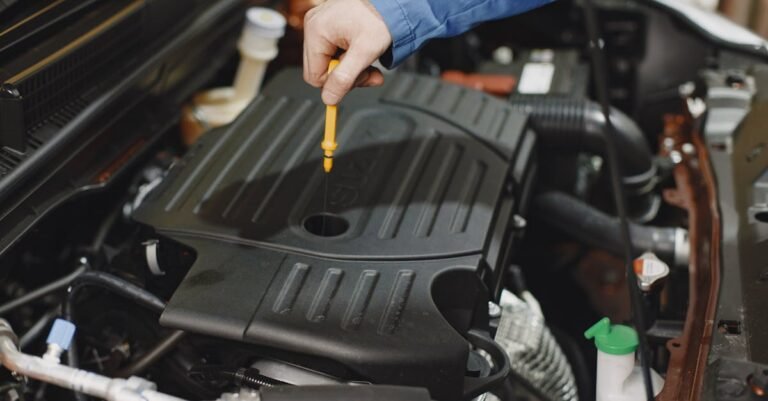Table of Contents
- DIY Oil Change Guide: Step By Step
- Why Bother Changing Your Own Oil?
- Before You Start: Gathering Your Tools and Supplies
- Step By Step: Let’s Get Greasy!
- Step 1: Prep Your Car and Workspace
- Step 2: Warm Up the Engine (Just a Bit!)
- Step 3: Lift and Secure Your Vehicle
- Step 4: Locate the Drain Plug and Filter
- Step 5: Drain the Old Oil
- Step 6: Replace the Drain Plug
- Step 7: Remove the Old Oil Filter
- Step 8: Prep and Install the New Filter
- Step 9: Add the New Oil
- Step 10: Run the Engine and Check for Leaks
- Step 11: Final Top Off and Clean Up
- Dealing with the Old Oil: Responsible Disposal
- Common Mistakes to Avoid
- Conclusion: You Did It!
- Frequently Asked Questions (FAQs)
DIY Oil Change Guide: Step By Step
Alright, let’s talk about getting your hands dirty, saving some cash, and giving your car a little TLC. Changing your own oil might seem like something only seasoned mechanics do, but honestly? It’s one of the most accessible and rewarding pieces of basic car maintenance you can tackle yourself. Forget waiting rooms and potentially inflated bills at the quick lube place. With a little preparation and this guide, you can totally nail your own oil change. Think of it as a rite of passage for any car owner who wants to be a bit more self sufficient. Ready to dive in?
Why Bother Changing Your Own Oil?
You might be thinking, “Why go through the trouble when I can just pay someone else?” Fair question! But hear me out, there are some pretty compelling reasons to roll up your sleeves.
Saving Money: The Obvious Perk
This one’s a no brainer. Labor costs money. When you take your car in, you’re not just paying for the oil and filter; you’re paying for the mechanic’s time, the shop’s overhead, and maybe even a little extra padding. By doing it yourself, you cut out the middleman. You buy the supplies directly – often you can find deals or buy exactly the quality of oil you prefer – and the only cost is your time. Over the life of your car, those savings really add up. Think about how many oil changes your car will need! That saved cash could go towards road trips, better tires, or, you know, more car parts!
Knowing It’s Done Right
Ever get that nagging feeling after leaving a service center? Did they really use the synthetic oil I paid for? Did they tighten the drain plug correctly? Did they even change the filter? While most shops are reputable, mistakes happen, and sometimes corners get cut, especially when they’re busy. When you do it yourself, you have complete control. You choose the oil, you choose the filter, you ensure everything is tightened to spec (not too tight, not too loose!), and you know exactly what went into your engine. It’s peace of mind you just can’t buy.
The Satisfaction Factor
There’s a unique sense of accomplishment that comes from doing your own maintenance. It demystifies your car a little bit. Instead of just being a machine that magically takes you places, you start to understand some of its basic needs. Successfully changing your oil builds confidence and might even inspire you to tackle other simple maintenance tasks. Plus, you get to brag a little, right? “Yeah, just changed the oil myself this weekend.” It feels good!
Before You Start: Gathering Your Tools and Supplies
Okay, convinced? Awesome. Before you pop the hood, let’s make sure you have everything you need. Nothing’s worse than getting halfway through a job and realizing you’re missing a crucial tool or part. A little prep work goes a long way here.
The Essentials List
Think of this as your oil change toolkit. Most of these are relatively inexpensive, and many are reusable for years to come.
New Oil (The Right Kind!)
This is crucial. Your car’s owner’s manual is your bible here. It will specify the type (conventional, synthetic blend, full synthetic) and, more importantly, the viscosity grade (like 5W-30 or 0W-20) your engine requires. It will also tell you the exact capacity – how many quarts or liters your engine holds. Don’t guess! Using the wrong oil can lead to poor performance, reduced fuel economy, and even engine damage down the line. Buy the correct amount plus maybe half a quart extra, just in case.
New Oil Filter
Just like the oil, you need the right filter for your specific vehicle (make, model, year, and engine size). Parts stores can easily look this up for you, or you can find it online. The filter traps contaminants, keeping your new oil clean for longer. Don’t skimp here; a quality filter is worth the small extra cost. Consider getting a filter that comes with a new drain plug gasket/washer if your car uses one – it’s good practice to replace it each time.
Wrenches (Socket/Box End and Filter Wrench)
You’ll need a wrench that fits your car’s oil drain plug. This is usually a specific size socket or box end wrench. Check your owner’s manual or do a quick online search for your car model to find the right size. Avoid using adjustable wrenches if possible, as they can round off the bolt head. You’ll also need an oil filter wrench. There are several types: band wrenches, socket style cap wrenches, or plier type wrenches. The cap style wrench that fits your specific filter is often the easiest to use, especially in tight spaces.
Drain Pan
You need something to catch the old, dirty oil. Get a dedicated oil drain pan, preferably one with a capacity larger than your engine’s oil capacity (to avoid overflows). Many have features like spouts for easy pouring and lids for transport to the recycling center. Don’t try to use an old bucket or cut open milk jug – they’re messy and prone to spills.
Funnel
A clean funnel is essential for pouring the new oil into the engine without making a mess. A long, flexible funnel can be particularly helpful if your oil fill cap is in an awkward spot.
Rags/Paper Towels
Oil changes can be messy. Have plenty of old rags or shop paper towels on hand for wiping up drips, cleaning the drain plug area, handling the oily filter, and wiping the dipstick.
Gloves and Eye Protection
Used motor oil contains contaminants you don’t want on your skin. Wear disposable nitrile or latex gloves. Eye protection (safety glasses or goggles) is also a must. You don’t want hot oil splashing in your eyes when removing the drain plug or filter.
Jack and Jack Stands (or Ramps)
Unless you drive a high clearance truck, you’ll need to lift the front of your car to access the drain plug and filter underneath. Never, ever work under a car supported only by a jack! Jacks can fail. Always use sturdy jack stands placed at the manufacturer’s recommended lifting points (check your owner’s manual). Alternatively, car ramps are a great, stable option if you have them. Make sure your vehicle is on a level, solid surface before lifting.
Step By Step: Let’s Get Greasy!
Alright, supplies gathered, safety gear on? Let’s walk through the process step by step. Take your time, especially the first time you do this.
Step 1: Prep Your Car and Workspace
Park your car on a flat, level surface like a garage floor or driveway. Avoid working on soft ground or inclines. Engage the parking brake firmly. If you have wheel chocks, place them behind the rear wheels for extra security, especially if you’re lifting the front.
Step 2: Warm Up the Engine (Just a Bit!)
Warm oil drains faster and carries more contaminants out with it than cold, thick oil. Run the engine for just 2-5 minutes. You want the oil warm, not scorching hot. Hot oil can cause severe burns, and exhaust components will be dangerously hot. Just warm enough to flow easily is perfect.
Step 3: Lift and Secure Your Vehicle
If using ramps, carefully drive the front wheels onto the ramps. If using a jack, consult your owner’s manual for the correct front jacking points. Lift the car high enough to comfortably work underneath. Immediately place jack stands under the designated support points (usually on the frame rails or reinforced pinch welds) and lower the car slowly onto the stands. Double check that the car is stable and secure on the stands before getting underneath.
Step 4: Locate the Drain Plug and Filter
Slide under the front of your car (feet first is often safest). Look for the engine’s oil pan – it’s typically a metal pan at the very bottom of the engine. The drain plug will be a large bolt head located at the lowest point of the pan. The oil filter is usually a cylindrical canister (often black, blue, or white) screwed into the side or bottom of the engine block. Its location varies greatly between vehicles, so consult your manual if you’re having trouble finding it.
Step 5: Drain the Old Oil
This is where the action happens!
Positioning the Pan
Slide your drain pan directly underneath the oil drain plug. Remember that the oil will likely shoot out initially, not just drip straight down, so position the pan slightly towards the rear of the plug to catch the initial stream.
Loosening the Plug
Put on your gloves and eye protection! Using the correct size socket or box end wrench, turn the drain plug counter clockwise (“lefty loosey”). It might be tight initially, so give it a firm, steady turn. Once it breaks loose, you should be able to unscrew it the rest of the way by hand. As you remove the final threads, be ready for the warm oil to gush out. Pull the plug away quickly and try not to drop it into the pan (though it happens!). Let the oil drain completely; this might take 5-10 minutes. You’ll see it slow from a stream to a drip.
Step 6: Replace the Drain Plug
Once the oil has slowed to an infrequent drip, wipe the drain plug clean with a rag. Inspect the plug and its gasket or washer. If your car uses a replaceable crush washer (common on many imports), now is the time to put the new one on the plug. Wipe the area around the drain hole on the oil pan clean. Carefully thread the drain plug back in by hand to avoid cross threading. Once it’s hand tight, use your wrench to snug it up (clockwise, “righty tighty”). Do not overtighten! This is a common mistake that can strip the threads in the oil pan, leading to a costly repair. Check your owner’s manual or look up the torque specification for your vehicle if you have a torque wrench. Otherwise, a firm snug tighten (usually about a quarter turn past hand tight) is sufficient. You want it tight enough not to leak, but not so tight you damage anything.
Step 7: Remove the Old Oil Filter
Now for the filter. Its location will determine how tricky this is.
Expect Some Spillage
Reposition your drain pan underneath the oil filter. Even though you’ve drained the pan, the filter still holds a fair amount of dirty oil that will spill out when you loosen it.
Using the Filter Wrench
Place your oil filter wrench onto the old filter. Turn it counter clockwise to loosen. It might be tight, especially if it was overtightened previously. Once it’s loose, you should be able to unscrew it the rest of the way by hand. Be prepared for oil to dribble down the sides. Keep the filter upright as much as possible as you lower it, then tip it over into the drain pan to empty.
Step 8: Prep and Install the New Filter
Almost there! Time for the clean parts.
Lubing the Gasket
Take your new oil filter. Dip a gloved finger into your container of new motor oil and wipe a thin film of clean oil onto the rubber gasket ring on the top of the new filter. This crucial step helps the gasket seal properly against the engine block and prevents it from sticking or tearing during installation and removal next time.
Hand Tightening is Key
Wipe the filter mounting surface on the engine clean with a rag, ensuring the old gasket didn’t stick there (it rarely does, but check!). Carefully screw the new, lubricated filter onto the threaded mounting point by hand, turning clockwise. Spin it until the gasket makes contact with the mounting surface. Then, tighten it further by hand only. The general rule is three quarters to one full turn after the gasket makes contact. Do not use the filter wrench to tighten the new filter! Hand tight is sufficient and prevents overtightening, which can damage the filter or make it incredibly difficult to remove later.
Step 9: Add the New Oil
Time to refill the heart of your engine.
Finding the Fill Cap
Lower the car if you haven’t already (remove jack stands/drive off ramps). Open the hood and locate the oil fill cap on top of the engine – it usually has an oil can symbol or the word “OIL” on it. Unscrew and remove the cap, placing it somewhere clean.
Using the Funnel
Insert your clean funnel into the oil fill hole. Slowly pour in the correct amount of new oil, minus about half a quart. For example, if your car takes 5 quarts, pour in 4.5 quarts initially. Pouring slowly helps prevent spills and allows air to escape.
Checking the Dipstick
Wait a minute or two for the oil to settle down into the pan. Remove the dipstick (usually has a brightly colored handle), wipe it clean with a rag, reinsert it fully, then pull it out again. Check the oil level against the markings (usually MIN/MAX or ADD/FULL lines). It should be near the ADD or MIN mark since you held back some oil.
Step 10: Run the Engine and Check for Leaks
Replace the oil fill cap securely. Start the engine and let it run for about 30-60 seconds. Watch the oil pressure light or gauge on your dashboard; the light should go out within a few seconds. While the engine is running briefly, quickly glance underneath the car (staying clear of moving parts!) to check for any drips from the drain plug or around the new oil filter. If you see leaks, shut off the engine immediately and tighten the leaking component slightly (remembering not to overtighten).
Step 11: Final Top Off and Clean Up
Shut off the engine and wait a few minutes (5-10 is good) for the oil to drain back into the pan. Check the dipstick again. Now, add small amounts of the remaining new oil, checking the level frequently, until the oil level is right at the FULL or MAX mark. Do not overfill! Overfilling can be just as harmful as underfilling. Once the level is correct, replace the dipstick and the oil fill cap. Wipe up any spills in the engine bay or on the ground. You’re done with the hard part!
Dealing with the Old Oil: Responsible Disposal
Okay, job done, but don’t just dump that old oil down the drain or onto the ground! Motor oil is toxic and harmful to the environment. Pour the old oil from your drain pan into the empty containers from your new oil (use the funnel!). Collect the old filter in a plastic bag as well. Most auto parts stores accept used motor oil and filters for recycling free of charge. Many local hazardous waste collection sites or recycling centers also take it. Call ahead to confirm their policies. Please, dispose of it responsibly – it’s easy to do!
Common Mistakes to Avoid
Even seemingly simple jobs have pitfalls. Here are a few common mistakes to watch out for during your DIY oil change:
Using the Wrong Oil Type or Amount
We stressed this before, but it bears repeating. Always use the viscosity and type specified in your owner’s manual. And double check the capacity – overfilling or underfilling can cause serious engine problems.
Overtightening the Drain Plug or Filter
It’s tempting to crank down on these parts to prevent leaks, but resist the urge! Overtightening the drain plug can strip the threads in the aluminum oil pan (expensive!). Overtightening the filter can damage the gasket or make it nearly impossible to remove next time. Snug is good; excessively tight is bad.
Forgetting to Lube the New Filter Gasket
That thin film of new oil on the rubber gasket is critical for a good seal and easy removal later. Skipping this step can lead to leaks or a filter that feels welded on during the next oil change.
Improper Vehicle Lifting/Securing
Safety first! Never rely solely on a jack. Always use jack stands placed on solid, designated points. Ensure the car is stable before getting underneath. Working on uneven ground is also a recipe for disaster.
Conclusion: You Did It!
Pat yourself on the back! You’ve successfully changed your car’s oil. You saved some money, you know the job was done meticulously with the right parts, and you’ve gained valuable experience and confidence. It might have seemed daunting at first, but like anything, it gets easier and faster with practice. Keep track of your mileage or date so you know when the next change is due (check your owner’s manual for the recommended interval), keep those tools handy, and enjoy the satisfaction of maintaining your own ride. Happy motoring!
Frequently Asked Questions (FAQs)
1. How often should I really change my oil?
The best answer is always in your vehicle’s owner’s manual. Manufacturer recommendations vary widely based on the engine, oil type (conventional vs. synthetic), and driving conditions. The old “3,000 miles” rule is often outdated for modern cars and oils. Many recommend intervals of 5,000, 7,500, 10,000 miles, or even more, especially with synthetic oil. Follow your manual’s guidance for “normal” and “severe” driving conditions.
2. Can I switch between conventional and synthetic oil?
Yes, generally you can switch back and forth or upgrade from conventional to synthetic oil without any issues in most modern vehicles. Synthetic oil offers better performance in extreme temperatures, better protection against wear, and often allows for longer change intervals. Check your manual just to be sure there aren’t specific contraindications for your model.
3. What do the numbers like “5W-30” mean?
This is the oil’s viscosity grade. The first number followed by “W” (for Winter) indicates the oil’s flow characteristics at cold temperatures (lower number means it flows better when cold). The second number indicates its viscosity at operating temperature (higher number means it remains thicker at high heat). Using the manufacturer recommended viscosity is crucial for proper lubrication in all conditions.
4. I slightly overfilled the oil. Is that okay?
A tiny amount over the MAX line (like 1/8 inch) is usually not a major concern. However, significantly overfilling can be harmful. Excess oil can get whipped into foam by the crankshaft, reducing lubrication effectiveness, and potentially causing pressure issues or damaging seals. If you’ve overfilled by more than about half a quart, it’s best to drain a little out through the drain plug until the level is correct.
5. Do I really need a torque wrench for the drain plug?
While highly recommended for accuracy and preventing damage, especially if you’re inexperienced, it’s not strictly mandatory if you’re careful. Many experienced DIYers develop a feel for how tight “snug” is. The key is to tighten it firmly enough to seal (often replacing the crush washer helps) but not so tight that you strip the threads. If you’re unsure, investing in an inexpensive torque wrench is a good idea for peace of mind.









